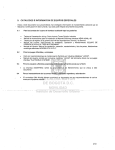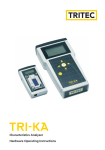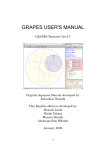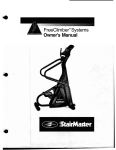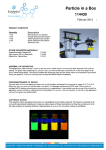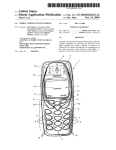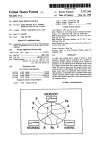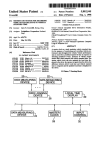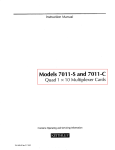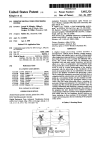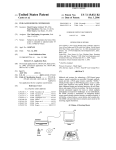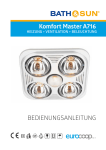Download “ruff, " x
Transcript
‘ 11300571497711 United States Patent [191 5,714,977 [11] Patent Number: [45] Date of Patent: Me Neil Feb. 3, 1998 [54] VIDEO PROCESSING SYSTEM FOR MOVEMENT SIMULATION 4,958,147 5,019,809 5,107,252 4/1992 Traynar et a1. ['75] Inventor: Ian Mc Neil. Newbury. England 5,124,693 6/1992 Himelstein et a1. .................. .. 345/139 9/1990 Kanema et a1. ...................... .. 340/729 5/1991 Chen . . .. .., . .. .. . . . .. . . . .. 345/157 345/139 FOREIGN PKI‘ENT DOCUMENTS [73] Assignee: Quantel Limited. Newbury. England 0283159 6362099 2119594 2157126 2158671 2174861 [21] Appl. No.: 465,969 [22] Filed: Jun. 6, 1995 Related U.S. Application Data [63] Continuation of Ser. No. 46,479, Apr. 12, 1993, abandoned, which is a continuation of Ser. No. 410,126, Sep. 20, 1989, abandoned, which is a continuation-impart of Ser. No. 159,780, Feb. 24, 1988, Pat No. 4,951,040. [30] [51] [52] 1/1987 8102939 10/1981 Japan . United United United United Kingdom Kingdom Kingdom Kingdom . . . . United Kingdom , WIPO . U1‘HER PUBLICATIONS Super 3D. Silicon Beach Software, User Manual. Copyright Primary Examiner-Regina D. Liang United Kingdom 8822003 Int. Cl.6 ..................................................... .. G096 5/08 U.S. Cl. ......................... .. 345/157; 345/122; 345/139 Attorney Agent, or Firm-Cooper & Dunham LLP [57] ABSTRACT A video processing system for use in creating apparent three 345/139. 122. dimensional movement of a two dimensional video image 345/138."145..“157. 121; 395/119. 127; on a display screen 20. At least one set of axes is displayed 348/578. 583. 590. 598; 382/276. 293. on the image to be moved. A computer 24. in response to signals from a user operated stylus 21 and touch tablet 22. controls the manipulation of image data in an image store 26 [58] Field of Search 296 [56] 2177871 European Pat. O?. . 1988. Foreign Application Priority Data Sep. 20, 1988 [GB] 9/1988 3/1963 11/1983 10/1985 11/1985 11/1986 to control apparent rotation of the image about, and/or linear References Cited movement along. an axis selected by the user. In the U.S. PATENT DOCUMH‘ITS 4,600,919 4,667,236 4,754,269 4,831,548 4,835,528 4,862,392 4,951,040 4,951 ,232 described embodiment several sets of linked axes are de?ned. Rotation or linear movement with respect to an axis 7/1986 5/1987 6/1988 5/1989 5/1989 8/1989 8/1990 8/1990 is controlled respectively by selecting a marker identifying the axes or a line representing the axis. Selection is made by way of a cursor under the control of the stylus and touch tablet. The system can also display a line representing the user de?ned movement of e. g. the center of the image. 17 Claims, 3 Drawing Sheets 1‘ x y::v/ Y z , 'l “ruff, " x 32 ‘35 l US. Patent ucgZCD .325 Feb. 3, 1998 __ Sheet 1 of 3 zuJczNl 6-3 232%5 IT .m 5328 52 » :55 mm US. Patent Feb. 3, 1998 Sheet 2 0f 3 5,714,977 I‘ I" NGE US. Patent Feb. 3, 1998 Sheet 3 of 3 5,714,977 5,714,977 1 2 VIDEO PROCESSING SYSTEM FOR MOVEMENT SIMULATION screen and manipulated by the user with his stylus and touch tablet. By providing a plurality of sets of axes and providing for selective movement in each axes set. the system provides This is a continuation of application Ser. No. 08/046479 ?led Apr. 12. 1993 now abandoned which is a continuation a means by which di?erent levels of movement of an image may be achieved as will become apparent from the follow ing. A ?rst level set of axes will normally be provided at the of application Ser. No. 07/410,126 ?led Sep. 20. 1989 (abandoned). which is a continuation~in~part of application Ser. No. 07/ 159.780 ?led Feb. 24. 1988 (U.S. Pat. No. centre of a picture. that is to say at the centre of a framed image. and the system arrangement enables the user to rotate 4.951.040). the picture with any axis of such ?rst set of axes or to move the picture with the origin of the axes set along the line of FIELD OF THE INVENTION any axis as required. The ?rst set of axes is normally set such that two of the axes are arranged to lie parallel to the x and The present invention relates to a video processing system having a facility for simulating three dimensional movement y directions of the picture (and of the display screen. assuming the picture edges are parallel to the edges of the of a live video picture. screen which will normally be the case) and a third axis is BACKGROUND OF THE INVENTION arranged to be perpendicular to the picture (and to the screen). Translation of the picture along the x and y axes. Video processing machines for simulating three dimen sional movement of a live video picture are known. Hitherto, when the x and y axes of the picture are parallel to the x and the controls for such machines have included switching y axes of the display screen. will simply cause the picture to shift left or right and up or down on the display screen. while translation along the z-axis will cause the size of the picture devices for selecting operations and movement detectors. such as levers and tracker balls. for de?ning the temporal to change as it moves in 3D space away from or towards the nature of the selected e?’ect. These controls provide a means display screen. The e?’ect of rotation of the picture about an by which a user of ?te machine can among other things achieve the e?’ect of apparent three dimensional movement 25 axis needs no explanation. Higher level sets of axes are also made available to be of for example live video pictures on a display screen. utilised successively. and can be located by the user at any However. such controls are limited in that multiple actua desired position in three dimensional space remote from the tions of different levers and switches together with move ?rst axis location. The origin of the ?rst set of axes. also ment of the tracker ball are required in order to achieve the called the picture level axes. (i.e. the centre of the image) is desired effect. Thus. e?icient use of the machine requires a maintained at a ?xed distance in three dimensional space high level of experience and dexterity on the part of the user from the origin of the second level axes and in this way rotation and translation of the picture in relation to a second level axis will cause movement of the picture in three and. whilst highly satisfactory effects are achievable using these controls. an undue amount of time can be spent by the user in achieving desired results. 35 OBJECTS AND SUMMARY OF THE INVENTION The principal object of the present invention is to provide a solun‘on to the above and associated limitations and to dimensional space as though the centre of the picture were ?xedly connected to one end of a rigid arm having its other end located at the origin of the second level axes and movable therewith in rotation and translation. Thus. trans lation and rotation of the second level axes may be e?ected to change the shape and size of the picture to accommodate provide an improved video processing system for image changes in perspective and viewing position as the image is manipulation to simulate movement. moved. Further higher levels of axes may be de?ned at other The invention generally resides in the concept of provid points in three dimensional space as required. Each level of ing an improved video processing system in which a set of axes will be maintained at a ?xed distance from the next axes can be displayed over an image and the image can be 45 higher level axes and in this way complex movements of the manipulated by reference to said axes by a user by way of picture through three dimensional space may be de?ned by input means to realise the desired simulated movement the user. e?‘ect. As will be explained in the following, in use of the system According to the invention in one of its aspcas tha'efore of the invention to simulate three dimensional movement of there is provided a video processing system for use in a video picture. the ?rst or picture level set of axes is creating apparent three dimensional movement of a video automatically displayed at the centre of the picture when the image on a display screen. in which system at least one set system is activated. The user can then translate and rotate the of axes is displayed and processing means responsive to user picture level set of axes as required by use of his stylus and operable input means are provided for processing image data touch tablet. When a second level set of axes is required this to control apparent rotational movement of the image about. $5 is derived from the picture level set of axes which is. in and/or apparent translational movement in the direction of. e?’ect. dragged out to the required origin position of the a user selected axis of said set. second set of axes. again by use of the stylus and touch In an embodiment of the invention. to be described in tablet. The second set of axes as thus established are thus greater detail hereinafter. a plurality of sets of axes are oriented identically to the orientation of the picture level set available to be selectively displayed and individual axes of axes at the time when the second set of axes are set up. within selected sets can be selected by the user by way of a Once the second set of axes has been set up. the user has the cursor displayed on the display screen. the position of the facility to rotate and translate in the second axes with cursor being controlled by use of the user operable input means. namely in the embodiment in question a pressure sensitive stylus and an associated touch tablet. The spatial relationship between the various sets of axes can be de?ned by the user by way of the cursor displayed on the display corresponding movement of the picture. Subsequent axes sets are similarly established. each subsequent axes set being 65 dragged out from the preceding set as above described in the case of the second and picture level set of axes. All axes sets that are set up by a user remain displayed and the usa' has 5,714,977 3 4 the option to work in any selected one of a series of sets of axes thus established. In order to facilitate use of the system each set of axes can natively the input may be in, say. D1 digital format, an be displayed as a set of lines representing the orientation of each axis in the set and accompanying labels which identify each axis, the system being arranged such that selection of approved digital standard for making digital video tape recordings from tape, disc or other digital processing sys tem. 5 The processing system is arranged under software control 23 to enable video signals supplied thereto via the input device 29 to be manipulated frame by frame in real time to a label by cursor control enables rotation about the associ ated axis to be effected and selection of a line enables translational movement along the associated axis to be produce special rotational and translational effects by writ ing pixels to the image framestore 26 in a ?rst order and reading them from the framestore 26 in a diiferent order. effected. Furthermore, the system may be con?gured so as to enable the display of a locus representing the movement of Image manipulation systems which operate in this way are known and gena'ally work as either read side systems, in which image data is written into a store in normal raster order and then read from the store for display in a di?’erent order, or write side systems, in which the order of the data is changed as it is written to the store and then is read conventionally. One example of a machine which writes to the picture in three dimensional space and/or representing the movement of the origin of a user selected set of axes in three dimensional space. The video picture may comprise a sequence of video frames and the system can be arranged such that at least some of the frames can be de?ned by the user as key frames which are displayed at user de?ned the store in normal raster order and then reads in a di?’erent order (read side) is manufactured by the present Assignee position within the three dimensional movement. The loca and sold under the trade mark “ENCORE" and is described in European Patent Publication No. ERA-0283159 and in tions of other frames in the sequence not having a user de?ned location can be calculated automatically by extrapo corresponding US. patent application Ser. No. 159780 and Japanese Patent Application No. Sho 63-62099 the disclo lation between user de?ned key?'ames. In this case the locations of keyframes in the movement are represented by ?rst markers in the locus displayed on the display screen. and the locations of other frames are represented by second markers in the locus. Thus according to another aspect of the invention there is provided a video processing system comprising frame stor sures whereof are incorporated herein by way of reference. Another machine which performs its manipulations while writing to a framestore and then reads in a conventional way (write side) is manufactured by the present Assignee and sold under the trade mark “MIRAG " and is described in UK Patent Applications Nos. 2119594 and 2158671 the age means, data processing means, a viewing screen and disclosures whereof are incorporated hereinv by way of use" operable means arranged for cooperation with said reference. Write side processing is generally the more processing means to eifect manipulation of frame store data di?icult, and the described embodiment of the present inven to simulate movement of a video image in three dimensional tion as represented in FIG. 1 is con?gured as a read side space. and wherein the system further comprises means for system though the invention could also be embodied in a storing data de?ning the nature of said manipulations, means 35 write side system. for determining address data representative of the positions The system according to the present invention does not of a predetermined element of a manipulated video image, and means for displaying connections between said posi require the control panel having switch buttons and a tracker tions to show the movements of said element. Further features of the invention are as set forth in the appended claims and. together with those features above mentioned, will become clear from consideration of the detailed description of an exemplary embodiment of the invention which will be given in the following with refer ence to the accompanying drawings. 45 ball that are provided in our earlier ENCORE machine but instead is arranged under software control so that all opera tions can be effected by use of the pressure sensitive stylus 21 upon the touch tablet 2. More particularly, in the system of the present invention, a movement of the stylus 21 on the touch tablet causes the touch tablet to output address signals representing movements in x and y directions as shown by the axes 30 in FIG. 1. An additional parameter of the movement is de?ned by the pressure that is applied to the BRIEF DESCRIPTION OF THE DRAWINGS stylus as sensed by means of a pressure transducer incor porated into the stylus, for example by application of stylus FIG. 1 shows a video processing system embodying the present invention; pressure in an on/olf fashion to de?ne start and end points of FIG. 2 shows an example of a typical display generated while using the system of FIG. 1; and lished sets of axes. The stylus 21 and touch tablet 2 enable an operation, e.g. the origin positions of successively estab the user to control the movement of a cursor on the display screen and in this way a mm is able to select an operation, FIG. 3 shows a locus representing movement of a point in the picture or the origin of a set of axes. DESCRIPTION OF THE PREFERRED EMBODIMENT A video processing system embodying the present inven 55 e?‘ect it and store the result without looking away from the monitor 20. The vast number of picture movements achiev able with a system of this type can be combined with previously known image processing features or options such as sizing, corner pinning etc selected from a menu displayed tion is shown in FIG. 1 as comprising a television type monitor 20, a pressure sensitive stylus 21 and a touch tablet 22 each connected to a processing system 23. The process ing system 23 includes a control computer 24, an address on the monitor. transforming circuit 25, an image framestore 26. a graphics Movement of the stylus swiftly across the edge of the touch tablet (a process known as swiping) is arranged in per se known manner to call up a menu of user selectable framestore 27 and a video combiner 28. In operation an options which can be displayed anywhere in the screen, for example in the lower. or upper. quarter of the screen. The input signal is supplied by an input device 29 which for live 65 menu may obscure the display area below it or alternatively video from a camera or an output from an analog video tape it may be made transparent. As the stylus is placed onto the recorder will include an analog to digital converter. Alter touch tablet a cursor is displayed on the monitor and is 5,714,977 5 6 controlled (moved) by moving the stylus on the touch tablet. An operation is selected by the user by moving the stylus so A menu (not shown) that is provided on the display sq'een enables the user to select a higher level axes set. for example that the cursor appears over the appropriate menu item and then pressing the stylus onto the touch tablet so as to cause the pressure transducer to output a signal to indicate to the located by use of the stylus and its pressure sensitive facility system the selection of the corresponding menu option. The system according to the present invention is therefore arranged by its software to be controlled in a very similar way to the video graphics system manufactured by the present Assignee and sold under the trade mark “PAINT BOX“. second level axes 34. and once selected the axes 34 can be on the touch tablet at any point in three dimensional space and thereafter rotation and/or translation in the second axes level can be e?‘ected. The distance in three dimensional space between the origin 32 of the picture level axes 31 and the origin of the second level axes 34 is held ?xed once it has 10 been set by the user. and is represented by the broken line 35 in the drawing. EJ112116!‘ higher levels of axes. for example As can be seen from the exemplary showing of FIG. 2 the image 33 read from store 26 has been reduced in size so that it occupies only part of the full screen of monitor 20. The system is arranged such that translational image movements can be controlled by operation of the stylus on the touch lines 38. 39. from the origins of the axes at the level below. tablet so as to position the cursor over an x. y or 2 letter Image manipulation by rotation and/or translation relative to associated with a particular set of axes. With the cursor so any axis of the successive hierarchical levels of user de?ned axes is etfected exactly as above described for the picture third level axes 36 and fourth level axes 37. may also be de?ned at other points in three dimensional space if so required, the origins of such axes being held respectively at user de?ned ?xed distances, represented in FIG. 2 by broken positioned. pressing the stylus on the touch tablet (and thereby activating the pressure transducer therein) causes the level axes. respective axis to be selected and thus allows movement in the selected axis direction to be effected by further move present invention may be likened to the behaviour of a ment of the stylus. Similarly identifying an axis by placing multiply articulated arm moving through three dimensional the cursor over the line representing it and pressing the stylus to indicate selection allows rotation about that axis to be controlled by the user. Since the of the ?rst set of axes 31 is always at the centre 32 of the picture, movement in relation to any point in 3D space other than in relation to the centre 32 of the pictin'e requires the operator to ascend to a higher level. ie a different set of axes 34, 36. 37. The on screen menu (not shown) provides for the selec tion of higher level axes. On selecting the second level, say. a second level reference point (origin) 34. with its accom panying set of axes oriented identically to the picture level axes 31. may be positioned anywhere on the screen by use of the stylus. By fur?ter use of the stylus in a manner as above described for the picture level axes 31 movements in The picture manipulation movements achievable by the space. This notional articulated arm would have three links 25 corresponding to the broken lines 35. 38 and 39 connected by ball joints at the origins of the axes 34 and 36 and with the centre 32 of the picture rotatably connected to the link 35 by a ball joint at the origin of axes 31 and the link 39 also conneaed to a ball joint at the origin of the axes 37. Since the articulated arm is merely notional. the links are such as 35 to allow total movement of the picture 36 apparently in three dimensional space. including the situation of two links of the arm occupying the same space. The link system is set up by the system user who determines the positions of the ball joints 34. 36. 37 and the lengths of the links 35, 38. 39 and the user is then free to de?ne movements of the picture axes 34. Similarly. at the third level movements of the origin by rotations and translations within the link system. In order to facilitate operation of the system. each level of operation (i.e. each set of axes and associated graphics) advantageously has an associated color relating to that level so that movements in any given level are represented in its of the second level axes 34 are de?ned with respect to the particular color. Thus the axes 31 for movement at the origin of the third level axes 36, and at the fourth and in this case highest level movement of the origin of the third level axes 36 is de?ned with respect to the origin of the fourth higher level axes 34, 36. 37 are displayed in different colors. 45 During the creation of a move. i.e. 3D movement of the this second set of axes can be e?’ected. At this second level the user instructions de?ne movements of the origin of the picture level axes 32 about the origin of the second level level axes 37. FIG. 2 shows the way in which picture movements may be controlled at di?’erent hierarchical levels by the use of a series of linked axes. On the display screen 20 a ?rst set of picture level are displayed in a picture level color. and the picture, only a single picture frame 33 is read from the image store 26 and displayed on the monitor 20 and this picture frame 33 remains on the monitor’s display whilst a move is being created. Video data for the or each set of axes 31. 34. axes 31 referred to hereinafter also as picture level axes. are 36. 37. and any other information to be displayed over the automatically set up at the centre 32 of a picture 33 in picture, for example the cursor, is stored in the graphics framestore 27 which is addressed in synchronismwith the response to user initiation of the system to enable the user selectively to rotate the picture with, or translate the picture in the direction of. any of the axes 31x, 31); 31; such rotation and/or translation being effected conventionally as hereinbefore described. ‘Two of the axes 31x, 31y lie parallel to the x and y directions of the pitxure 33 and initially (before any picture rotation) of the display screen 20, and the third axis 312. is arranged to be perpendicular to the picture and thus initially (before any picture rotation) to the display image store 26. However once the move has been de?ned. sequential frames of live video etc may be written to the 55 store 26 via input device 29. The computer 24 includes a screen 20. Each axis 311:, 31); 311 is represented on the information required by the operator is displayed on the monitor 20. The apparent three dimensional movement of the picture as de?ned by the operator is stored as a sequence of address signals de?ning how each frame of the video piaure sequence will be manipulated to represent the move display screen by a line indicating the orientation of the axis and a letter x. y or 2 identifying the axis, and image manipulation is effected by operation of the stylus/touch memory device for storing a sequence of manipulated read address signals representing the move. As the move progresses a narrow band of colour can usefully be arranged to move across the top of the screen to inform the operator how much memory space is available. and in this way all the tablet to move a cursor on the display screen and by means 65 of the cursor to select either rotation or translation relative ment. Movements are usually required to be smooth but not to a selected axis. Higher levels of axes may also be utilised all addresses. either spatially or temporally. need to be 5,714,977 7 8 stored. because intermediate addresses may be calculated by extrapolation. Thus in de?ning a movement only certain to other uses in addition to assisting identi?cation of the nature of the effect. The system can be arranged so that the addresses for so-called “key” frames, i.e. image frames having a position actually de?ned by the operator, need to be locus may be modi?ed interactively by operation of the stylus 21 upon the touch tablet 22 with the modi?ed coor dinates then being fed to the computer 24 to de?ne the position of new key frames. Once a new key frame position has been set. a line curving algorithm can be used to stored and intermediate frames can be calculated by extrapo lation between key ?ame addresses. Thus for example, a pendulum movement of the picture may be de?ned by movement along the X axis about a higher level reference reposition other ?ames to maintain a smooth movement point. The positions of maximum displacement in such a effect over time. As the cursor moves over a locus it jumps move may be de?ned as key frames and intermediate frames 10 between the discrete frame positions 45 to 49 for example. may be automatically calculated. The pendulum effect is then created by running the system and its speed is deter mined by the number of intermediate frames of the input piaure sequence which are generated between key ?ames. For a particular video production. and for future general A frame representing the shape of the picture at each frame position on the locus can also be displayed. Thus the shape of the locus in 3D space can be changed by moving the cursor to a point 45 to 49 and dragging the point to a new 3D position. A frame moved in this way need not be a key frame. it can instead be an intermediate frame, but it will become a key ?ame once it has been repositioned. There has thus been described a video processing system reference. an operator may store a library of effects on a disc memory device which provides fast and substantially ran dom access loading of data to the system‘s transforming circuit 25. Effects are di?icult to describe and classify in a way which has any obvious meaning and therefore a par ticular previously de?ned e?’ect will usually be arranged to be located by the user by previewing a number of elfects ?om disc. The provision of the graphics store 27 also allows additional features to be provided which are not present in hitherto known systems. In accordance with another feature of this embodiment. the system may advantageously be arranged to display on the monitor address data in the form 20 displayed on the display screen and a computer 24, in response to signals ?om a user operated stylus 21 and touch tablet 22, controls the manipulation of image data in an 25 of a locus which shows the movement of a predetermined picture element over the duration of the effect. The locus, or string, represents the movement over time of the etfect and thus may be previewed by the user to assist in the identi? cation of a previously de?ned eifect. FIG. 3 of the accompanying drawings is an exemplary showing of the locus 40 of the centre point of the picture, i.e. the origin of axes 31. which constitutes in this example the abovementioned predetermined picture element. Locii be displayed representing movement of the origin of each set of embodiment in question is exemplary only and that modi of appropriate knowledge and skills may be made without departure from the spirit and scope of the invention as set forth in the appended claims and equivalents thereof. I claim; 1. A video processing system for use in creating apparent three-dimensional movement of an entire video picture 45 whereas a few large segments will represent a fast effect. picture ?ame; a generating means for generating three-dimensional axes signals, representing at least one set of three perpendicularly to the locus 40 at the relevant positions. Locii are calculated using the same process that is used on dimensional axes having a predetermined positional relationship to the video picture ?ame, for display with the video picture ?ame; processing means for processing said video picture frame each image picture point during the elfect. As is known for example ?om our European Patent Application, Publication No. EP-A-0283 159 aforementioned three dimensional movement of a pitxure which gives rise to new co-ordinates (x‘,y',z') in three dimensional space can be de?ned as a to effect three-dimensional transformations thereof; combining means for combining the processed video function of the original coordinates (x, y) in the two dimen sional space of the monitor display. Once de?ned, the three picture ?ame and three-dimensional axes signals to produce a transformed video picture ?ame in combi dimensional coodinates are then projected onto the two dimensional plane of the monitor display screen and this gives new two dimensional co-ordinates (x". y") as functions of the three dimensional co-ordinates. The movement of the picture may therefore be de?ned as two functions de?ning played on the monitor 20. via graphics store 27. it can be put frame on a display, the system comprising: a source of video signals representing a multiplicity of picture elements which together form said entire video such as the small lines 50 that are shown in FIG. 3 extending Once a locus or string 40 has been calculated and dis to a preferred embodiment it is to be well understood that the ?cations and variations such as will occur to those possessed The positions of key ?ames may be identi?ed by markers the positions of x" and y" with respect to the original x and y coordinates. Thus x", y" coordinates are calculated for the centre of the image for each frame making up the etfect. image store 26 to control rotational or translational move ment of the image, with respect to an axis selected by the user. In the described embodiment several sets of linked axes may be de?ned. Rotational and translational movement with respect to an axis is controlled respectively by selecting a marker identifying the axis or by selecting a line represent ing the axis. Selection is made by way of a cursor under the control of the stylus and touch tablet. The system can also display a locus representing the user de?ned movement of e.g. the centre of the image. Having thus described the present invention by reference 35 axes in the corresponding colour associated with that level. The locus 40 thus may be displayed as indicated schemati cally in FIG. 3 as a series of segments 41 to 44 etcetera alternating in colour between the relevant level colour and another predetermined colour, say black. The points 45 to 49 at which segments meet represent the positions of frames of the video image, and the number of segments along the locus 40 represents the speed of the effect. A relatively large number of small segments will thus represent a slow e?'ect, for use in creating three dimensional movement of a video image on a display screen 20. At least one set of axes is nation with the at least one set of three-dimensional axes; a display screen connected to said combining means for display of the transformed video picture frame; and user operable input means for selecn'ng a marker identi fying at least one axis of said at least one set of 65 displayed axes by controlling the position of a cursor displayed on said display screen, said processing means effecting said three-dimensional transformations in 5,714,977 10 9 response to said selection of said marker. the three video frames, the system comprising key frame de?ning dirnensional transformations causing apparent rota tional movement of the displayed video picture frame about. or apparent translational movement of the dis played video picture frame in the direction of. or apparent rotational movement of the displayed video picture frame about and translational movement of the displayed video picture frame in the direction of said at means responsive to user manipulation of the user operable input means for de?ning at least some of the frames of said sequence as key ?ames and position de?ning means respon sive to user manipulation of the user operable input means for de?ning positions in said apparent three-dimensional movement of the picture for display of said key frames at respective ones of said user de?ned positions. the locus signal generating means comprising means for generating locus signals in which the locations of key ?ames in the movement are represented by ?rst markers in the locus and the locations of other frames are represented by second markers in the locus. 10. A method of simulating three-dimensional movement of an entire live video picture comprising: least one axis identi?ed by said marker. 2. A system as claimed in claim 1. in which the combining means comprises means for combining the axes signals representing said at least one set of three-dimensional axes with said video signals such that the combined signal represents the set of axes positioned at the center of the picture. 3. A system as claimed in claim 1 or 2. in which: providing video signals de?ning a multiplicity of picture the generating means comprises means for generating axes signals representing a plurality of sets of three elements which together form said entire live video picture ?ame and axes signals de?ning a set of axes having a selected positional relationship to said entire dimensional axes; and the system further comprises cursor generating means for generating cursor signals representing a cursor for 20 display by the displaying means. the cursor signals representing the cursor at a position determined by user manipulation of the user operable input means. the cursor signals being combined into said combined processed video picture frame and three-dimensional axes signals by said combining means and the at least one set of axes being selectable by way of the displayed the cursor to point to at least a part of at least one of said displayed axes and specifying movement therealong or cursor. 4. A system as claimed in claim 3, further comprising means. responsive to user determined positions of the cursor 30 displayed on the display screen. for de?ning a spatial relationship between each set of displayed three about at least one of said axes by controlling the position of the cursor to point to at least a part of at least one of said displayed axes and specifying movement thereabout through the pointing process; and spatially transforming the entire picture frame and the dimensional axes. axes in accordance with said commands and displaying 5. A system as claimed in claim 3. in which the video signals represent a video picture comprising a sequence of live video picture ?ame; displaying both the picture ?ame and said set of axes; generating a cursor to be displayed together with said picture frame and said axes; using an operator controlled device to generate commands for movement of said entire picture ?ame either along at least one of said axes by controlling the position of 35 video frames, the system comprising key frame de?ning means responsive to user manipulation of the user operable input means for de?ning at least some of the frames of said sequence as key ?ames and position de?ning means respon sive to user manipulation of the user operable input means the spatially transformed picture frame and axes. whereby apparent three-dimensional movement is stimulated. 11. Amethod as in claim 10. in which the step of using an operator controlled device to generate commands for move ment of said entire picture ?ame along or about at least one of said axes comprises pointing to at least one selected part for de?ning positions in said apparent three-dimensional of at least one of the displayed axes. said cursor being movement of the picture for display of the key frames at respective ones of said user de?ned positions. 6. A system as claimed in claim 5, including interpolating means for calculating by interpolation. between user de?ned key ?ames. positions of other frames in the sequence not having a user de?ned position. 7. A system as claimed in claim 1. in which the generating displayed together with said entire picture frame and said axes. and selectively manipulating the device to move the cursor along at least one displayed axis to oomrnand move means comprises means for generating signals representing ment of the entire picture ?ame therealong or selectively manipulating the device to command a rotation of the entire picture ?ame about at least one displayed axis. 12. A method as in claim 11. in which the step of the at least one set of three-dimensional axes as a set of lines 50 providing axes signals comprises providing signals de?ning representing the orientation of each axis and a set of labels which identify each axis for use as said marker. the pro cessing means being responsive to the selection of a label for eifecting said rotational movement about the or each asst» ciated axis. and being responsive to the selection of a line for effecting said translational movement in the direction of the associated axis. 8. A system as claimed in claim 1. further comprising a set of three-dimensional axes. locus signal generating means for generating locus signals representing a locus depicting said apparent three dimensional movement in respect of a prede?ned part of the 55 13. A method as in claim 12. wherein the video signals de?ne a video picture comprising a sequence of video ?ames. and including the steps of using the operator con trolled device to de?ne selected ?ames of the sequence as key ?ames and to de?ne selected positions of said key frames in said apparent three-dimensional movement of the picture. 14. A method as in claim 13. including the step of interpolating parameters of ?ames in the sequence which are picture or of said at least one set of three-dimensional axes. intermediate said key ?ames from information pertaining to the key frames. the locus signals being combined by said combining means into said combined processed video picture frame and generating locus signals representing a locus depicting the 15. A method as in claim 14. including the step of 65 simulated three-dimensional movement of a selected part of three-dimensional axes signals. the picture or of at least one set of three-dimensional axes. 9. A system as claimed in claim 8. in which the video and displaying said locus. signals represent a video picture comprising a sequence of 5 ,714,977 11 12 16. A method as in claim 10. wherein the video signals de?ne a video picture comprising a sequence of video frames. and including the steps of using the operator con- 17. A method as in claim 10. including the step of generating locus signals representing a locus depicting the simulated three~dimensional movement of a selected part of trolled device to de?ne selected frames of the sequence as the picture or of at least one set of three-dimensional axes, key frames and to de?ne selected positions of said key 5 and displaying said locus. frames in said apparent three-dimensional movement of the picture. * * * * *










